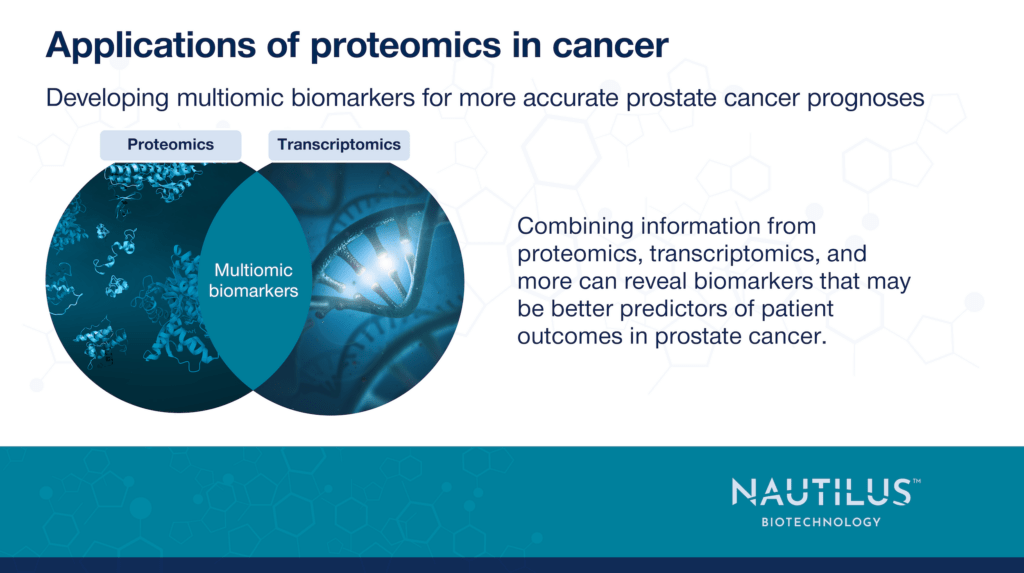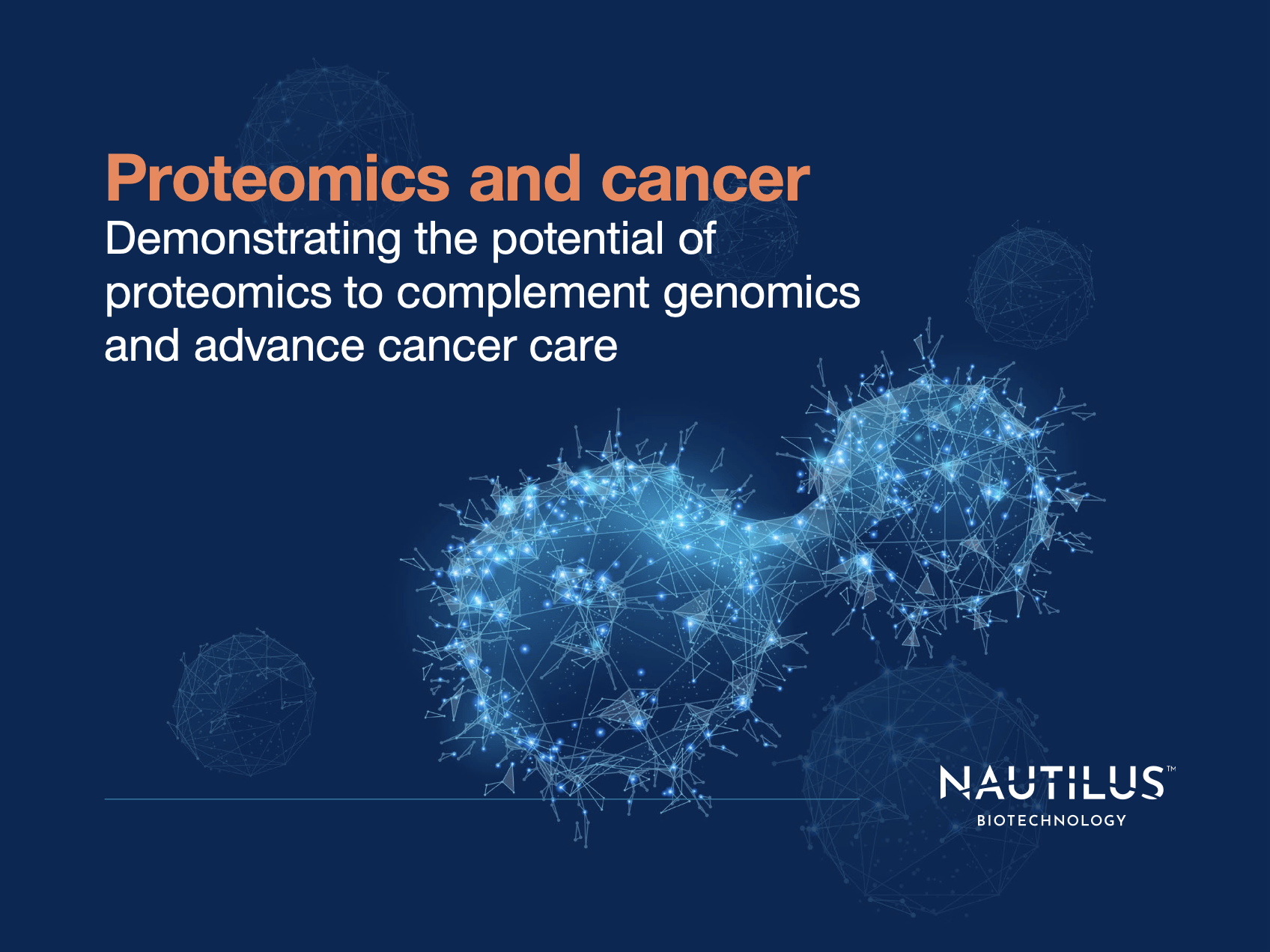
Applications of proteomics in cancer – Multiomic study highlights the value of the proteome for prostate cancer prognoses

Tyler Ford
December 5, 2023

In the United States, one in every eight men will be diagnosed with prostate cancer at some point in their life, according to the American Cancer Society. That number is even higher for Black men. Regular screenings can help diagnose the disease early and save lives, but some cases can be more aggressive than others. Additionally, existing cancer drugs don’t work for every patient.
Genetic alterations significantly impact prostate cancer risk and prognosis but are far from the end of the story. It’s less clear how differences at the epigenomic, transcriptomic, and proteomic levels affect cancer outcomes. Studies in various types of cancer and other model systems have shown that genomic changes may not be strongly linked to changes at other levels. Thus, more effective biomarkers for prostate cancer progression could come from studying other omes or linking information from multiple omes.
In a study published in Cancer Cell, Sinha et al. 2019 applied genetic, epigenetic, transcriptomic, and proteomic profiling to see how changes at the genetic level flow through to other biology in prostate cancer. They found that genetic changes are often poorly linked to changes at the level of the transcriptome and proteome, and that transcriptomic and proteomic changes frequently do not align. Further, multiomic signals yielded significantly better biomarkers and predictions of patient outcomes than any single analysis alone.
What is multiomics?
Multiomic studies like this one combine information from multiple levels of biology to reveal more complete information about a given biological process. Multiomics may pull from genomics, transcriptomics, proteomics, metabolomics, and other such “omes” to link changes in one domain to those in another. For example, proteins can be modified after being created from mRNA transcripts, creating proteoforms that can have different functions than the original protein. Using just genetics or transcriptomics wouldn’t reveal these proteoforms.
Multiomic analysis reveals proteomic and transcriptomic biomarkers can complement one another
Sinha et al. 2019 performed a multiomic analysis of 76 samples from patients with localized, intermediate-risk prostate cancer who’d been treated with a prostatectomy. They analyzed their genomes, epigenomes, transcriptomes, and proteomes, and assessed how these datasets aligned with each patient’s prognosis and treatment outcome.
Based on their data, the researchers grouped patients into four genetic subtypes and five proteomic subtypes. These subtypes aligned poorly with each other, indicating mutated genes weren’t always causing changes to their associated proteins. That’s a sign the proteome contains information about prostate cancer the genome doesn’t, and studying it could reveal new prostate cancer insights. Indeed, several groups of proteins were associated with clinical phenotypes. For example, a group of 421 proteins correlated with percent genome altered (PGA), a biomarker of more aggressive prostate cancer, while a different group of eight proteins was associated with tumor size.
The research also highlighted the significance of fusion proteins containing the ETS-domain (this domain was originally named after the “E twenty-six” oncogene). These gene fusions are common in prostate cancer patients and are thought to occur early in tumor development. With their multiomic analysis, the researchers were able to see that ETS fusions typically have stronger effects on the proteome than the transcriptome, making proteomic analysis a much more effective tool for assessing their impact. For example, ETS fusions left lysyl oxidase gene expression little changed at the RNA level but caused a 21,031 fold increase in protein abundance.
The researchers also used an information content analysis to see how genomic changes flowed through to proteomic changes and found significant variations between proteins. For example, less than 10 percent of PTEN abundance, but around 60 percent of NDRG3 abundance, was explained by genetic, epigenetic, and transcriptomic changes. Altogether, this data highlights the complexity of the relationship between genomic and proteomic changes and indicates the relationship is likely to be unique for each gene.
Combining prostate cancer biomarkers for improved prognoses
DNA and RNA-based biomarkers are commonly used for prostate cancer, but it’s currently difficult to adequately diagnose various kinds of prostate tumors. As a result, some patients receive treatment they don’t need, while others may not receive it quickly enough.
To find better biomarkers, Sinha et al. 2019 generated 10 million sets of 100 randomly chosen genes and assessed the performance of these sets as biomarkers on genetic, epigenetic, transcriptomic, and proteomic levels. The researchers found RNA and protein biomarkers derived from these gene sets performed better than other types of biomarkers. Furthermore, pairing up sets of biomarkers, they found that combined methylation-protein biomarkers yielded the best performance overall. This work sets the stage for the development of novel biomarkers and highlights the benefits of leveraging multiomic data.
An important role for next-generation proteomics: developing and applying biomarkers for prostate cancer
Today, technologies for proteomics cannot fully analyze a sample, meaning potential biomarkers could be missed. Additionally, high-throughput clinical tests based on proteomics are not yet part of routine practice, making it challenging to utilize new biomarkers clinically.
Next-generation proteomics technologies, like the NautilusTM Proteome Analysis Platform could begin to change that. The Nautilus Platform is designed to be more sensitive, have a higher dynamic range, and higher throughput than current technologies. It may make analyzing the full proteome possible for more scientists. With such platforms, researchers may discover new multiomic biomarkers like those described above. Doctors may one day use next-generation platforms to apply these biomarkers in the clinic and improve patient lives.
Watch this animation to discover more of what proteomics can teach us about cancer:
MORE ARTICLES

